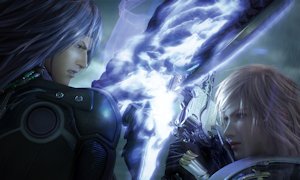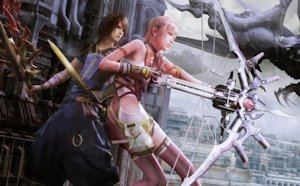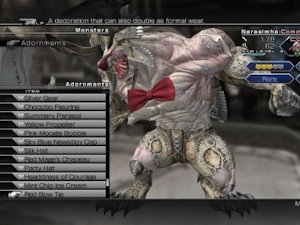Review: Final Fantasy XIII-2
Final Fantasy XIII is probably the most harshly criticized single-player game in the entire canon of the flagship JRPG franchise. Though much of this criticism may be undeserved (see my own review), it seemed unwise for Square Enix to push forward with a direct sequel in Final Fantasy XIII-2. Even if XIII-2 manages to be the best Final Fantasy game yet, a huge section of the target fanbase is automatically going to ignore it, because many seem to hate XIII that much. Still, does XIII-2 address the problems of XIII or is it just another retread?
STORY
 | | Lightning spends the entire game on a single boss fight |
Three years after our heroes destroyed Orphan and began settling on Gran Pulse, a bizarre meteorite crashes near the town of New Bodhum, home to Lightning's sister, Serah. Serah's memories of what happened three years earlier are slightly different than everyone else's, and she is certain that her sister is still alive and out there somewhere, despite apparently disappearing when Cocoon began to fall. The meteorite, along with a visitor from the future named Noel Kreiss, provides the first hint of an answer: something has gone wrong with time itself, and both Serah and Noel must embark upon a confusing trip through multiple timelines in order to figure out how to fix things and find Lightning, who is locked in eternal combat outside of history with a mysterious foe who is apparently immortal.
Despite paradoxical meanderings and a plot that doesn't make complete sense, this is a much simpler story than that of XIII, eschewing deep backstories and multiple protagonists for a more fast-paced adventure involving just the two heroes. For the vast majority of the game, you play as only Serah and Noel, which is a surprise given that Lightning--who is only in the game for maybe a grand total of thirty minutes--is on the game cover and title screen. Still, this much more direct approach gives a potentially chaotic narrative the simplicity it needs to succeed.
It also helps divorce this entry from its predecessor by putting you in the shoes of characters who weren't really in XIII (Serah is a crystal for most of the first game, and Noel is introduced for the first time in the opening scenes of XIII-2). Though some familiar faces pop in and out of Serah and Noel's journey, this game stands almost completely alone, not requiring players to have any real knowledge of Lightning's quest to save Cocoon. Newcomers can skip XIII altogether, if they so choose, and can catch a quick recap of the story so far in the game's menus. Another major difference between the two is that the antagonist of XIII-2 is more understandable than the generically evil psuedo-gods of XIII.
 | | I'm pretty sure their weapons are bigger than they are |
It's quite amazing how the story is able to hold together despite the fact that one can tackle many parts of it out of order. Indeed, with so many multiple timelines, there is no "right" order in which to go, making this the least linear Final Fantasy game of them all, a bold counterpoint to XIII's much maligned linearity. There are a handful of necessary plot progressions that must be tackled in order, but players will spend far more time exploring sidequests, backtracking to discover new things in old locations (or unlock new paths of sideways progression), and even replaying earlier sections with your advanced level and items intact. The game encourages this, even using a handful of minor fetch quests to make it necessary. There are some things you can't do until you've completed the main quest, and these "Paradox Endings" (all but one of which is impossible to find before beating the final boss) elaborate on some of the plot's more mysterious points, offering logical answers to questions left lingering by the briskness of the adventure.
However, even though XIII-2 manages to improve upon XIII's greatest fault--the intense linearity--it still falls into some of the same traps. For example, Noel comes into the story knowing quite a bit about what's going on, but Serah never bothers to press him for information, leaving the audience unnecessarily frustrated until Noel finally volunteers little nuggets of his knowledge as the quest goes on. There's also plenty of JRPG melodrama, cheesy dialogue, and long-winded monologue digressions that seem to offer no point, but it wouldn't be Final Fantasy without them. Also, as one of the few who really likes XIII, I would have appreciated a little more connective tissue between the two games.
|
[Story: 9.5 - This is a much tighter and more cohesive narrative that is far more straight-forward and satisfying than its predecessor.]
|
|
GAMEPLAY
 | | Let's not dwell on the fact that you can put a bow tie on a behemoth |
I often wonder why Square Enix didn't decide to make XIII-2 stand alone as Final Fantasy XV, but the thing I keep going back to is the gameplay. The excellent paradigm system from XIII is back, now even faster and more responsive. You can now switch between the two party members at will, and the death of the party leader will no longer end the battle. The roles from XIII are preserved--commando, ravager, medic, etc--as is the amazing battle A.I. Combat in XIII-2 is tense and quick, requiring lightning reflexes and keen strategizing. One change is the number of paradigms you can have on standby, which is reduced to six, never quite enough for every situation. Some of the bigger battles will require multiple attempts to get right, making victory surprisingly rewarding.
Unfortunately, the crystarium system also returns, and is made even simpler, making leveling up a yawn-worthy affair that is far too gradual to be any fun. On the plus side, customizing your weaponry isn't nearly as tedious as it is in XIII, and you will actually want to find new weapons throughout the game instead of holding on to a weak one just because you've spent so much time and energy upgrading it. And, given the wealth of sidequests and hidden locales, it is entirely possible to go hunting for weapons, something you simply could not do in XIII.
Another interesting change is the inclusion of monster hunting, which completely replaces summoning. There is a third slot in your party that is filled by one of three tamed monsters, each one specializing in one of the game's roles. You can collect almost any monster in the game (except bosses and human characters), and once you have one, you can upgrade it in a number of ways: either through leveling up via specialized items (similar but better than the weapon upgrade system from XIII) or by absorbing another tamed monster, imbuing some of its abilities. Each monster has a special limit-break-style super attack that is triggered through quicktime events, and they are probably the most useful tactics in your bag of tricks. The entire monster hunting gimmick works far better than one would expect, and it's easy to find yourself spending so much time collecting and building better monsters that you forget to tackle anything story-related for long stretches.
-e. magill 11/27/2012
|
|